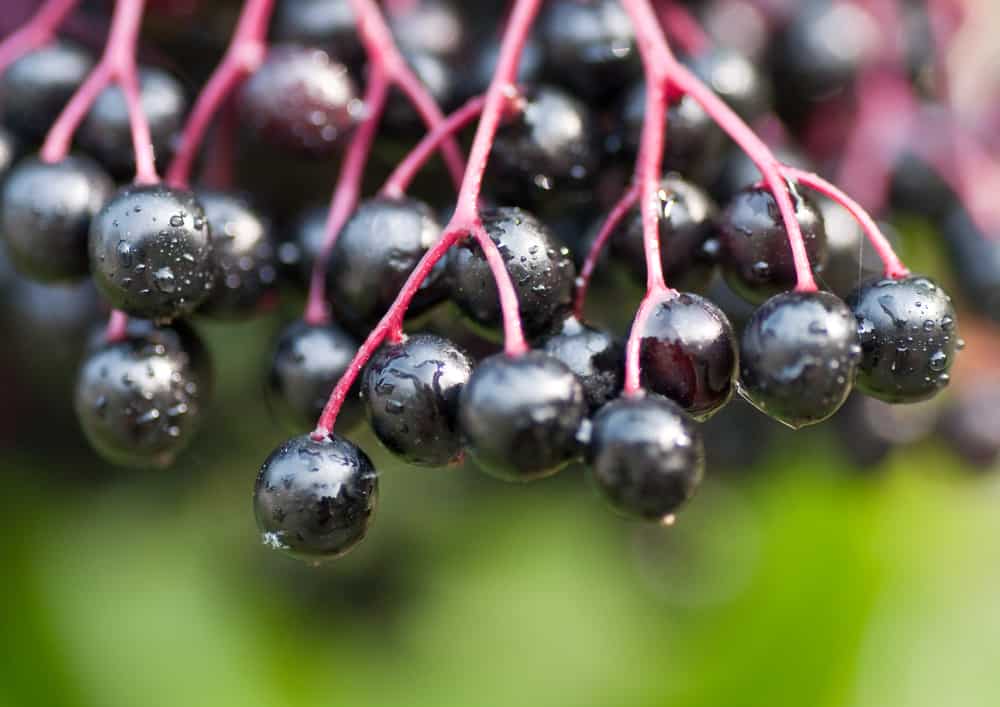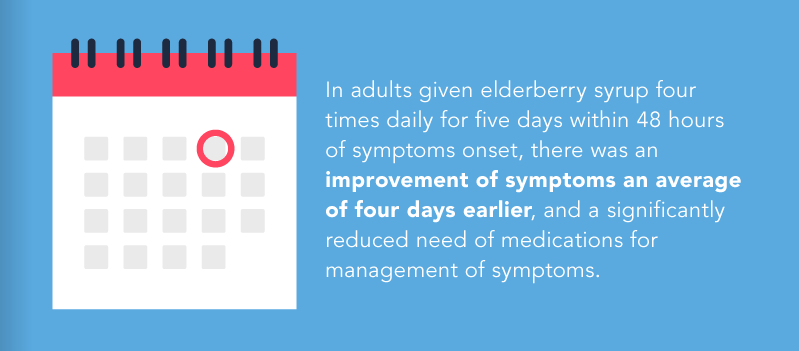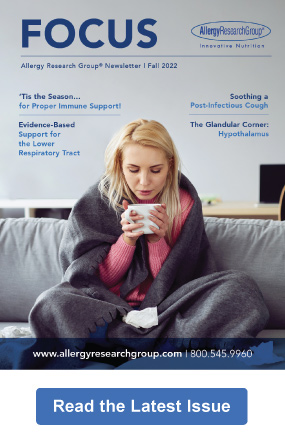Share this post
Pleasant-tasting purple berries provide powerful immune protection
Black elderberry (Sambucus nigra), much like echinacea, takes its place in our botanical medicinal cabinet seasonally when the seasonal colds and flu are at large. Because of elderberry’s naturally appealing taste, it is a botanical that we commonly find as a pleasant tasting syrup or chewable. But that doesn’t mean it lacks health benefits – on the contrary, many studies suggest it is indicated for protection and recovery from seasonal influenza and viral infections,[1],[2] the data which we look at herein.
An interesting, unexpected history
Elderberry may have one of the most dynamic histories of the botanicals we continue to use medicinally. Evidence of its cultivation dates back to 4,000 to 3,000 BCE, and it is written of by the philosophers and physicians of ancient Greece and Rome.[3] Some report it as the tree by which Judas Iscariot met his end, other accounts say the cross of Calvary was made of its wood. Its medicinal uses in early times, much like echinacea, include ailments ranging from toothache to rheumatism to fever. Its medicinal powers went from popularity with the ancient Greeks to being seen as a force of magic and the tree a residence for spirits of both good and evil. The tree and its branches have been sacrificial offerings, given for good luck at weddings, and buried in or planted on graves. This really reflects only a small fraction of the powers that were once attributed to the unpretentious and small elder tree, which we now seek out for immune protection.
A potent array of antioxidant compounds
Potent antioxidants also often carry anti-inflammatory properties as well, which has been shown to be true for elderberry and its constituents.
Numerous studies have assessed the compounds found in elderberry which possibly mediate its medicinal action, finding that it contains high levels of polyphenolic antioxidants – primarily anthocyanins, proanthocyanidins/flavanols, flavonols, and phenolic acids – which may convey an array of health benefits.[1],[4],[5] Potent antioxidants also often carry anti-inflammatory properties as well, which has been shown to be true for elderberry and its constituents.[6],[7]
Bioactive compounds found at high levels in elderberry include quercetin and its derivatives, rutin, and cyanidin-based anthocyanins.[8],[9] One of these anthocyanins, cyanidin-3-O-glucoside (C3OG), also found in other red and blue fruits and berries, has demonstrated noteworthy neuroprotective, cardiovascular, and antidiabetic benefits.[10],[11] Anthocyanins found in elderberry also support the recycling of other antioxidants like α-tocopherol, a form of vitamin E.[12] Bioavailability studies suggest that the health-promoting anthocyanin compounds found in elderberry fruit achieve their peak serum concentrations roughly one hour after ingestion, which in part explains the frequent dosing we see clinically in acute settings.[9]
A modern herbal antiviral
Clinically, we see the majority of research with elderberry focused on its effects as an antiviral agent. In cellular and animal studies, both C3OG and elderberry juice concentrate have been shown to have antiviral effects against influenza infection by reducing viral entry and cell-to-cell transmission, while whole elderberry concentrate also enhanced the immune response.[1],[13] In addition to inhibiting both influenza A and B, elderberry extract also has been shown in cell studies to inhibit Streptococcus pyogenes, group C and G Streptococci, and Branhamella catarrhalis, common bacterial causes of upper respiratory infections.[14] Antiviral effects also have been shown against herpes simplex virus and human immunodeficiency virus.[1] Studies suggest elderberry may have higher immunostimulatory effects than echinacea, another common botanical traditionally taken to prevent or reduce the severity of seasonal infections.[15]
In addition to inhibiting both influenza A and B, elderberry extract also has been shown in cell studies to inhibit Streptococcus pyogenes, group C and G Streptococci, and Branhamella catarrhalis, common bacterial causes of upper respiratory infections.
These effects also play out clinically in a variety of settings. In a randomized, double-blind, placebo-controlled trial (RDBPCT) of a population of adults and children clinically diagnosed with influenza, more than 90% of those given black elderberry extract had a significant improvement in symptoms within two days, while the same level of improvements was seen by day six in the placebo group.[16] The elderberry extract was taken twice daily by children and four times daily by adults for only three days in this investigation.
A larger multicenter RDBPCT looked at the impact of elderberry syrup on adults diagnosed with influenza.[17] In those given elderberry syrup four times daily for five days within 48 hours of symptoms onset, there was an improvement of symptoms an average of four days earlier and a significantly reduced need of medications for management of symptoms.
A third RDBPCT had similar findings, showing that individuals clinically diagnosed with influenza who were given elderberry extract four times daily for two days had improvements in all symptoms (including resolution of fever) within 48 hours while the control group experienced a worsening of symptoms over the same period.[18]
A recent randomized, double-blind, placebo-controlled trial found that overseas economy air travelers who took the placebo had significantly longer and more severe cold symptom scores than those who took elderberry.
The most recent 2016 RDBPCT took a quite different approach, providing elderberry extract to adult travelers flying economy class from Australia to an overseas destination a minimum of seven hours flight time away.[19] Participants were instructed to take the elderberry product or placebo twice daily for 10 days prior to travel and three times a day during travel and upon arriving at their destination for an additional five days. Those in the placebo group who experienced cold symptoms had them significantly longer and the average symptom score was significantly higher than in the elderberry group. Although more respiratory disease symptoms were seen in the placebo group both before and after travel, the difference was not significant.
Safety
Commercial products properly made with elderberry fruit have a high level of safety and have been studied as a short-term intervention for treatment of influenza in both adults and children.[16],[20] In adults, it also has been used longer-term up to 12 weeks with no adverse effects.[21] Because of its ability to stimulate immune function it should be used with caution in individuals with autoimmune disease. A 2014 review reports that at the time, there were no animal or human studies of elderberry safety in pregnancy.[22]
It is important to note that homemade elderberry products should be used with caution due to potentially cytotoxic compounds found in the leaves, branches, flowers, and unripe fruit, which can lead to nausea, vomiting, and diarrhea.[1],[9] Proper cooking of the fruit or boiling the juice should be adequate to denature these hazardous compounds.[23]
Naturally, there are upsides when a dietary supplement is something that we enjoy taking, especially when it appeals to children too. Elderberry really is the kid-tested, mother-approved favorite for good reason!
Click here to see References
[1] Porter RS, Bode RF. A review of the antiviral properties of black elder (Sambucus nigra L.) products. Phytother Res. 2017 Apr;31(4):533-54.
[2] Zakay-Rones Z, et al. Randomized study of the efficacy and safety of oral elderberry extract in the treatment of influenza A and B virus infections. J Int Med Res. 2004 Mar-Apr;32(2):132-40.
[3] Salamon I, Grulova D. Elderberry (Sambucus nigra): from natural medicine in ancient times to protection against witches in the middle ages-a brief historical overview. International Symposium on Elderberry. 2013 Jun 9;1061:35-9.
[4] Duymuş HG, et al. In vitro antioxidant properties and anthocyanin compositions of elderberry extracts. Food Chem. 2014 Jul 15;155:112-9.
[5] Petruţ GS, et al. Chemical profiles and antioxidant activity of black elder (Sambucus nigra L.) – a review. Bull UASVM Food Sci Technol. 2017;74(1):9-16.
[6] Izzi V, et al. The effects of dietary flavonoids on the regulation of redox inflammatory networks. Front Biosci (Landmark Ed). 2012 Jun 1;17:2396-418.
[7] Ho GT, et al. Elderberry and elderflower extracts, phenolic compounds, and metabolites and their effect on complement, RAW 264.7 macrophages and dendritic cells. Int J Mol Sci. 2017 Mar 8;18(3):584.
[8] Veberic R, et al. European elderberry (Sambucus nigra L.) rich in sugars, organic acids, anthocyanins and selected polyphenols. Food Chem. 2009 May 15;114(2):511-5.
[9] Młynarczyk K, et al. Bioactive properties of Sambucus nigra L. as a functional ingredient for food and pharmaceutical industry. J Funct Foods. 2018 Jan;40:377-90.
[10] Cásedas G, et al. Cyanidin-3-O-glucoside inhibits different enzymes involved in central nervous system pathologies and type-2 diabetes. S Afr J Bot. 2019 Jan 1;120:241-6.
[11] Olivas-Aguirre FJ, et al. Cyanidin-3-O-glucoside: physical-chemistry, foodomics and health effects. Molecules. 2016 Sep 21;21(9):1264.
[12] Abuja PM, et al. Antioxidant and prooxidant activities of elderberry (Sambucus nigra) extract in low-density lipoprotein oxidation. J Ag Food Chem. 1998 Oct 19;46(10):4091-6.
[13] Kinoshita E, et al. Anti-influenza virus effects of elderberry juice and its fractions. Biosci Biotechnol Biochem. 2012;76(9):1633-8.
[14] Krawitz C, et al. Inhibitory activity of a standardized elderberry liquid extract against clinically-relevant human respiratory bacterial pathogens and influenza A and B viruses. BMC Complement Altern Med. 2011 Feb 25;11:16.
[15] Barak V, et al. The effect of Sambucol, a black elderberry-based, natural product, on the production of human cytokines: I. Inflammatory cytokines. Eur Cytokine Netw. 2001 Apr-Jun;12(2):290-6.
[16] Zakay-Rones Z, et al. Inhibition of several strains of influenza virus in vitro and reduction of symptoms by an elderberry extract (Sambucus nigra L.) during an outbreak of influenza B Panama. J Altern Complement Med. 1995 Winter;1(4):361-9.
[17] Zakay-Rones Z, et al. Randomized study of the efficacy and safety of oral elderberry extract in the treatment of influenza A and B virus infections. J Int Med Res. 2004 Mar-Apr;32(2):132-40.
[18] Kong FK. Pilot clinical study on a proprietary elderberry extract: efficacy in addressing influenza symptoms. Online Journal of Pharmacology and Pharmacokinetics. 2009;5:32-43.
[19] Tiralongo E, et al. Elderberry supplementation reduces cold duration and symptoms in air-travellers: a randomized, double-blind placebo-controlled clinical trial. Nutrients. 2016 Mar 24;8(4):182.
[20] Rauš K, et al. Effect of an echinacea-based hot drink versus oseltamivir in influenza treatment: a randomized, double-blind, double-dummy, multicenter, noninferiority clinical trial. Curr Ther Res Clin Exp. 2015 Apr 20;77:66-72.
[21] Curtis PJ, et al. Cardiovascular disease risk biomarkers and liver and kidney function are not altered in postmenopausal women after ingesting an elderberry extract rich in anthocyanins for 12 weeks. J Nutr. 2009 Dec;139(12):2266-71.
[22] Holst L, et al. Echinacea and elderberry – should they be used against upper respiratory tract infections during pregnancy? Front Pharmacol. 2014 Mar 4;5:31.
[23] Bolarinwa IF, et al. A review of cyanogenic glycosides in edible plants. Toxicology-New Aspects to This Scientific Conundrum. 2016 Oct 26.
The information provided is for educational purposes only. Consult your physician or healthcare provider if you have specific questions before instituting any changes in your daily lifestyle including changes in diet, exercise, and supplement use.
Share this post
Dr. Carrie Decker
Related posts
Molecular Hydrogen and Autoimmune Disease
Multiple clinical studies report improvements in autoimmune disease with hydrogen treatment Although hydrogen (H2) is well known as an alternative fuel, recognized as such in the Energy Policy Act of 1992, only in 2007 did it begin to really make the scene in medicine. Although used for the purpose of preventing decompression sickness in…
The Antiviral and Anti-Inflammatory Potential of Quercetin
The value of quercetin for respiratory health beyond allergies Quercetin is another well-known member of the polyphenol family. Considered a flavonoid type of polyphenol, quercetin is found in many fruits and vegetables, including onions, apples, cherries, broccoli, tomatoes, and berries, as well as green tea. We look to quercetin most often seasonally as a…
Memorize That Mushroom: Lion’s Mane
Food for cognitive health My grandmother lived to be 98 years old, and her mind remained sharp to the very end. When asked to divulge her secret, she proudly explained that she completed a New York Times crossword puzzle every day in order to keep her brain active. (Luck may also have been a…
Zinc for Immunity and Healthy Aging
Zinc is an essential nutrient for immunity and healthy aging Zinc is a trace mineral that is essential for growth, reproduction, and good health throughout life.[1],[2],[3] It is required for the structure and function of literally thousands of different proteins, including enzymes, transporters, and transcription factors.[4],[5] One of the most important roles of zinc…
Maritime Pine Bark Extract: An Anti-Aging Solution?
The anti-aging and metabolic benefits of this highly-researched pine bark compound Maritime pine bark extract, sourced from the maritime pine (Pinus pinaster Aiton), has a long history of use both in industry and in medicine. The tree has been widely used since the 16th century in Europe as source of timber as well as…
Pine Bark for Blood Vessels Big and Small, Part 2 of 2
A natural solution for erectile dysfunction, cold hands, and vision In Post 1 of 2, we explored the effects of maritime pine bark extract on blood pressure, hemorrhoids, and varicose veins. In this post we’ll zoom in on the extract’s effects on smaller blood vessels. Let’s take a closer look at the vascular diseases…
Categories
- Botanicals (56)
- GI Health (53)
- Healthy Aging (121)
- Immune Support (39)
- In The News (39)
- Kids Health (21)
- Stress and Relaxation (50)
- Uncategorized (1)
- Video (9)
- Vitamins & Minerals (51)





